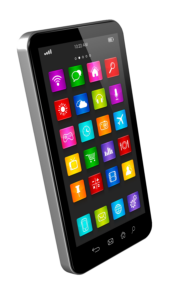Mobile-First Design
In today’s mobile-centric world, mobile-first development is the name of the game. It’s about creating websites and apps that excel on small screens while still impressing on larger ones. With responsive design, your content effortlessly adapts to various devices, ensuring a seamless experience for users, whether they’re on a smartphone or a desktop computer. Speed is the key – mobile-first development optimizes performance to keep users engaged, preventing frustrating loading times. Above all, it’s a user-centric approach, using specialized tools and methods to prioritize the mobile experience and leave users delighted with their digital journey
Imagine your web design project as a journey, with mobile users as your first-class passengers. Start by making your website mobile-friendly, ensuring it looks great and functions smoothly on smaller screens. Use handy design tools that love mobiles, focus on speed to accommodate slower connections, test your design on actual mobile devices for usability, and the best part is, this mobile-first mindset doesn’t just cater to mobile users; it ensures a fantastic experience for everyone, no matter their device, making your website a true digital superstar.
Mobile-First Technology, Future of Mobile Web and its SEO
Embracing the Mobile-First strategy is essential for boosting your website traffic and capitalizing on potential customer acquisition and sales opportunities. In today’s digital landscape, with approximately 90% of the population relying on mobile devices for not only calls and texts but also internet access and app usage, it has become a critical factor for success.
Many prominent companies have leveraged mobile apps to engage with customers and deliver services effectively. It’s imperative to embrace this approach, given its ongoing development and optimization to cater to the ever-evolving innovations in mobile devices.
Additionally, considering Mobile SEO Ranking Factors is crucial to ensure that your website not only caters to mobile users but also performs well in search engine results, enhancing your visibility and attracting organic traffic.
The Importance of Mobile-First Design in Transforming Your Website and Its Impact.
Mobile App Design is an approach to web and app design that prioritizes the development of the mobile version of a website or application before designing for larger screens, such as desktops or tablets. When you prioritize mobile, you’re forced to focus on essential features and content, resulting in faster load times and improved overall performance. This is critical for user satisfaction, as slow-loading sites can lead to high bounce rates. This approach has become increasingly important for several reasons
Mobile Usage Dominance
Mobile devices have become the primary means of accessing the internet for a significant portion of the global population. As of my last knowledge update in September 2021, mobile usage had already surpassed desktop usage in many regions. This trend has likely continued, making it crucial to cater to the mobile audience.
__________________________________________________________
Responsive Design
Mobile-Optimized Websites is a fundamental component of responsive web design, which aims to create a seamless user experience across various screen sizes and devices. Starting with mobile ensures that your website or app will function well on smaller screens and then adapt gracefully to larger ones.
__________________________________________________________
Better SEO
Search engines like Google prioritize mobile-friendly websites in their search rankings. Google’s mobile-first indexing means that it primarily uses the mobile version of a site to determine its ranking in search results. Failing to have a mobile-friendly design can negatively impact your search engine visibility.
___________________________________________________________
Wider Audience Reach
By starting with a mobile-first approach, you ensure that your website or app is accessible to users across a broad spectrum of devices, including older smartphones and tablets with varying screen sizes and capabilities. This inclusivity can help you reach a more extensive audience.
___________________________________________________________
Future-Proofing
With the continuous evolution of mobile technology, designing for mobile-first positions your digital presence for future advancements. As new devices and screen sizes emerge, your Mobile Content Layout can adapt more easily to these changes.
____________________________________________________________
Cost-Efficiency
Fixing design issues and optimizing performance on larger screens after initially designing for desktop can be costly and time-consuming. Starting with mobile-first can save resources by addressing potential problems early in the design process.
Mobile App Design is essential because it aligns with the changing landscape of technology and user behavior. Prioritizing mobile ensures that your digital products are accessible, user-friendly, and performant, ultimately leading to better user experiences and improved business outcomes.
How to Implement a Mobile-First Design.
Implementing a Mobile-First Development Frameworks is crucial for creating responsive and user-friendly websites and applications. Mobile App Design and Mobile Content Layout prioritizes the design and development of the mobile version of a website ensuring a seamless user experience across all devices. Analyze user device preferences and screen sizes to create personas, ensuring responsive design that adapts to various screens. Continuously test and optimize for performance, focusing on essential content for a user-centric experience.
Prioritize Vital Content and Embrace Responsive Grids – Ensure a user-friendly mobile experience by identifying and prioritizing crucial content and features. Highlight what users need most on smaller screens. Implement a flexible grid system that adapts effortlessly to varying screen sizes, utilizing percentage-based or fluid layouts for seamless element reflow.
Harness CSS Media Queries for Screen-Specific Styles: Employ CSS media queries to tailor styles for various screen sizes, commencing with mobile and progressively enhancing for larger displays. Ensure responsive images and videos by applying CSS rules like max-width: 100% to prevent overflow within containers.
Create Mobile-Friendly Design with Ease: Craft a touch-friendly design with larger buttons and easy navigation while mindful of spacing. Implement progressive disclosure via collapsible menus and tabs to declutter the interface on smaller screens. Prioritize legible fonts and sizes for readability without the need for zooming.
Optimize for Performance, Test Thoroughly, and Scale Up: Prioritize performance optimization by compressing images, reducing HTTP requests, and applying lazy loading techniques, catering to users with limited bandwidth and slower devices. Conduct extensive testing across various mobile devices and browsers, collecting user feedback for continuous improvement. Once the mobile design is refined, progressively enhance it for larger screens with media queries, incorporating more complex layouts, larger images, and additional features as necessary. Ensure cross-browser compatibility by testing on popular mobile browsers such as Chrome, Safari, Firefox, and Edge, guaranteeing a seamless experience for all users.
Prioritize Accessibility, Document, and User Test: Make your mobile design accessible for users with disabilities by using semantic HTML, offering image alternative text, and adhering to accessibility guidelines. Document your design choices and CSS rules for future maintenance and updates. Conduct usability testing with real users on mobile devices, collecting feedback and adjusting based on user behavior and preferences to ensure a user-friendly experience for all.
By following these steps and adhering to Mobile-First SEO Tips , you’ll create a responsive and user-friendly experience for your audience, regardless of the device they use to access your website or application.
Examples of Successful Mobile-First Application Designs.
Mobile-first design is a crucial approach in today’s digital landscape, where mobile devices dominate user access to the internet. Designing with mobile users as the primary focus not only enhances user experience on small screens but often leads to more streamlined and efficient designs across all devices. Here are  some examples of successful mobile-first design implementations:
some examples of successful mobile-first design implementations:
Instagram– which offers a visually appealing platform for sharing photos and videos exclusively on mobile devices..![]()
Uber– has transformed transportation with its user-friendly app for booking rides and managing payments.
Tinder– simplifies dating through its swipe-based mobile interface.
![]() Google Maps– seamlessly adapts to mobile screens, providing navigation, real-time traffic updates, and local business informat
Google Maps– seamlessly adapts to mobile screens, providing navigation, real-time traffic updates, and local business informat![]() ion.
ion.
WhatsApp– focuses on real-time communication for smartphone users.![]()
Airbnb– mobile app delivers an immersive travel booking experience.
Snapchat– encourages real-time sharing with features like disappearing messages and Stories.
Duo lingo– gamifies language learning on mobile devices.
Spotify– offers personalized music streaming with a mobile-first approach.![]()
Starbucks– streamlines the coffee-buying process with mobile payments, loyalty rewards, and order-ahead features.
These examples showcase the effectiveness of designing with mobile users in mind, resulting in user-friendly and engaging experiences.
Uncover new trends in digital marketing and technology, enhance your marketing efforts and boost website traffic. Explore our Marketing Technology Blog, or gain insights into the full range of services provided by Tower Agency.



 Reliable, vigilant, and determined.
Reliable, vigilant, and determined.